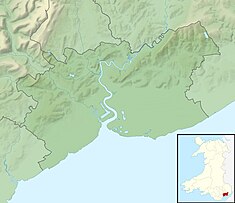| Penhow Castle | |
|---|---|
 | |
| Type | Castle |
| Location | Penhow, Newport |
| Coordinates | 51°36′49″N 2°50′01″W / 51.6137°N 2.8337°W / 51.6137; -2.8337 |
| Built | 12th century onwards |
| Architectural style(s) | castellated |
| Governing body | Privately owned |
| Listed Building – Grade II* | |
| Official name | Penhow Castle |
| Designated | 1 March 1963 |
| Reference no. | 3078 |
| Listed Building – Grade II | |
| Official name | Barn to south-west of Penhow Castle |
| Designated | 24 February 1976 |
| Reference no. | 3056 |
| Listed Building – Grade II | |
| Official name | L-shaped Byre Range to south-west of Penhow Castle |
| Designated | 24 February 1976 |
| Reference no. | 17079 |
| Listed Building – Grade II | |
| Official name | Stable Block to far south-west of Penhow Castle |
| Designated | 19 December 1995 |
| Reference no. | 17081 |
| Listed Building – Grade II | |
| Official name | Five bay Barn and attached Byre to far south-west of Penhow Castle |
| Designated | 19 December 1995 |
| Reference no. | 17080 |
 | |
Penhow Castle, Penhow, Newport dates from the early 12th century. Extended and reconstructed in almost every century since, it has been claimed to be the oldest continuously-inhabited castle in Wales. The castle is a Grade II* listed building.
History
The manor of Penhow was held by Caradog ap Gruffydd, prince of Gwent at the time of the Norman invasion of Wales. The estate was seized by the Seymour family (anciently de St. Maur) and by 1129, Sir Roger de St Maur had built a fortified manor at the site. The house was extended and further fortified in the 15th and 17th centuries. In the 16th century, the manor passed to the Somersets. In 1674, it was purchased by the Lewis family of St Pierre. Viscount Rhondda, an industrialist and conservator of ancient buildings in Wales, bought the castle in 1914. By the mid-20th century, the castle was in a state of some dilapidation, until bought and restored by the film director Stephen Weeks. During his tenure, the castle was open to the public, while also serving as Weeks’ residence. In 2002, it was sold and reverted to a private home. Penhow is frequently claimed to be the oldest continuously inhabited castle in Wales.
Architecture and description
The architectural historian John Newman, in his Gwent/Monmouthshire Pevsner, describes Penhow as "small and convincingly defensive". It is constructed of local Old red sandstone rubble. The oldest portion of the castle is the west tower, which dates from the time of the Seymours. The two-storeyed hall range is later, of the 14th-15th centuries. Further large-scale remodelling took place in the 17th and 18th centuries, when the castle was refashioned as a comfortable country house. The Cadw listing records notes the "exceptionally fine Restoration period interiors”. The castle is listed Grade II*.
Two ranges of ancillary buildings contain some important agricultural structures, each with their own listings. The grouping immediately to the south-west of the castle includes a barn and a byre. The grouping further from the castle to the south includes an additional barn, another byre and a stable block.
Notes
- John Newman suggests Cardiff Castle, Fonmon Castle and St Donat's Castle as alternative claimants.
References
- ^ Cadw. "Penhow Castle (Grade II*) (3078)". National Historic Assets of Wales. Retrieved 22 March 2020.
- "Penhow Castle". www.castlewales.com. Castles of Wales. Retrieved 22 March 2020.
- "Penhow Castle (The Gatehouse Record)". www.gatehouse-gazetteer.info. The Gatehouse Gazetteer. Retrieved 22 March 2020.
- ^ Staff writer (16 April 2003). "Has Penhow Castle got American owners?". www.southwalesargus.co.uk. South Wales Argus.
- "Castle closes gates to visitors". BBC News. December 31, 2002. Retrieved 22 March 2020.
- Newman 1995, p. 552.
- "Penhow Castle". www.castlexplorer.co.uk. Castles of England, Scotland & Wales. Archived from the original on 14 April 2015. Retrieved 25 May 2018.
- ^ Newman 2000, pp. 464–465.
- Cadw. "Barn to south-west of Penhow Castle (Grade II) (3056)". National Historic Assets of Wales. Retrieved 22 March 2020.
- Cadw. "L-shaped Byre Range to south-west of Penhow Castle (Grade II) (17079)". National Historic Assets of Wales. Retrieved 22 March 2020.
- Cadw. "Five bay Barn and attached Byre to far south-west of Penhow Castle (Grade II) (17080)". National Historic Assets of Wales. Retrieved 22 March 2020.
- Cadw. "L-shaped Byre Range to far south-west of Penhow Castle (Grade II) (17082)". National Historic Assets of Wales. Retrieved 22 March 2020.
- Cadw. "Stable Block to far south-west of Penhow Castle (Grade II) (17081)". National Historic Assets of Wales. Retrieved 22 March 2020.
Sources
- Newman, John (1995). Glamorgan. The Buildings of Wales. London: Penguin Books. ISBN 9780140710564. OCLC 231881843.
- — (2000). Gwent/Monmouthshire. The Buildings of Wales. London: Penguin. ISBN 0-14-071053-1.